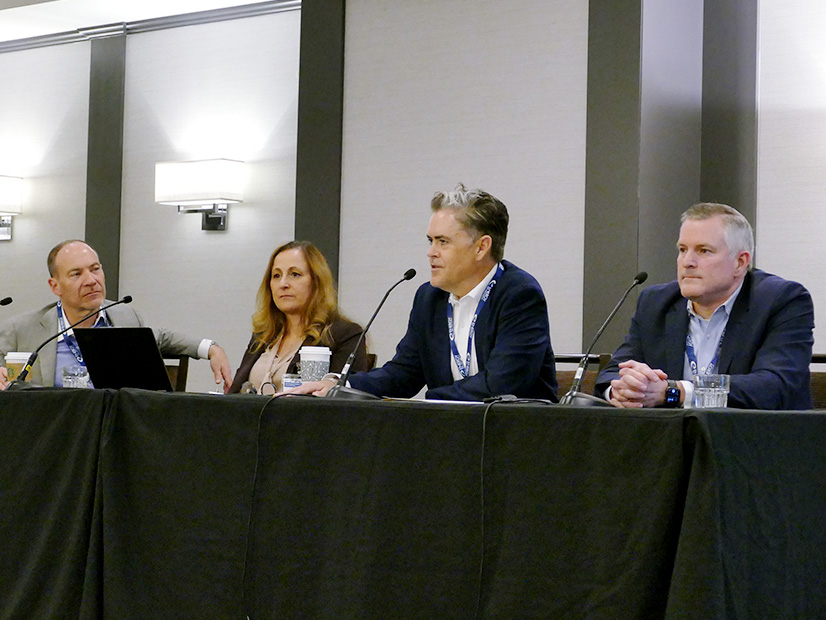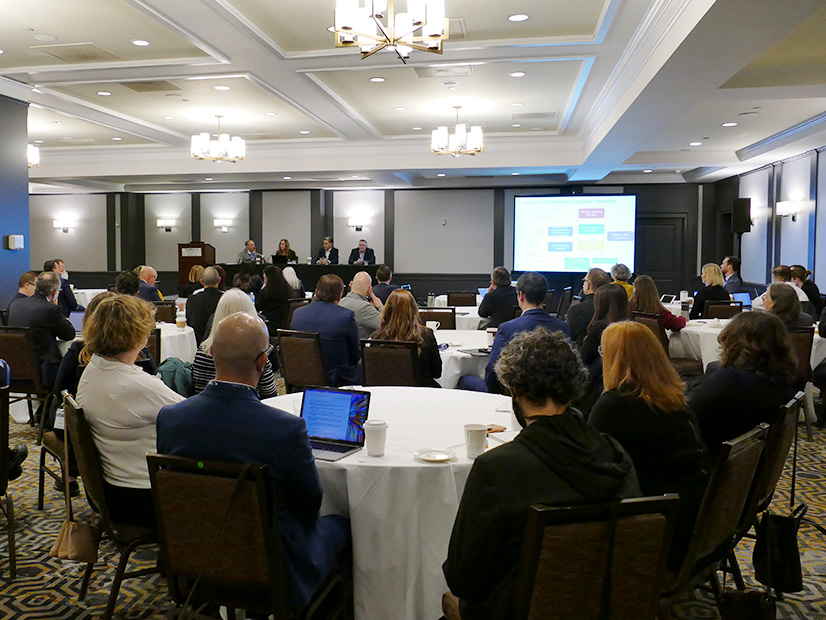SAN FRANCISCO — CAISO had just won approval from its Board of Governors last month for a day-ahead extension of its Western Energy Imbalance Market when a state lawmaker introduced a bill a week later to allow the ISO to become an RTO, CEO Elliot Mainzer recalled Thursday in his keynote address at the Energy Bar Association Western Chapter’s annual meeting.
 CAISO CEO Elliot Mainzer | © RTO Insider LLC
CAISO CEO Elliot Mainzer | © RTO Insider LLC
“Some of us thought, ‘Oh boy, we just got EDAM [the extended-day ahead market] done. Wouldn’t it be nice to have a little bit of time just to let that play out and let that evolve?’” Mainzer said. But the “zeitgeist in the West” is one of rapidly evolving efforts to organize the region’s balkanized electricity sector into markets and programs that could lead to RTOs, he said. (“Zeitgeist” is a German word meaning “the spirit of the times.”)
The measure introduced Feb. 8, Assembly Bill 538, by Assemblymember Christopher Holden would allow CAISO to develop a plan for governance independent of California’s governor and legislature, with a governing body that could include members from other states. (See Lawmaker Introduces Bill to Turn CAISO into RTO.)
“The reality is that … outside of California, I think a lot of people who are thinking about making significant additional investments either in the day-ahead market or even beyond … want to see a pathway to independent governance for the ISO,” Mainzer said. “And I think they need to see that as a way to get them comfortable staying with [CAISO and the Western EIM] and continuing to invest and grow with our organization as it evolves.”
Mainzer’s remarks in his keynote address were part of a discussion at the meeting about efforts by CAISO, SPP, the Western Power Pool (WPP) and others to assemble the West’s 39 balancing authorities into mutually beneficial organizations for resource adequacy, transmission planning and market transactions.
About 100 energy lawyers gathered at the historic Westin St. Francis hotel on San Francisco’s Union Square for the chapter’s first in-person meeting since the COVID-19 pandemic began three years ago.
WRAP and EDAM
 WPP CEO Sarah Edmonds | © RTO Insider LLC
WPP CEO Sarah Edmonds | © RTO Insider LLC
In a panel on resource adequacy, WPP Executive Director Sarah Edmonds described FERC’s recent approval of the group’s Western Resource Adequacy Program, a West-wide RA effort with 18 participants and three more expected to join. (See FERC Approves Western Resource Adequacy Program.)
The order allows the WRAP to move forward with a binding phase of its program, which would hold members accountable for failing to meet their resource requirements as part of the RA pool.
“We are currently working to identify what season WRAP goes binding,” Edmonds said. “The tariff that [FERC] approved allows flexibility for the region to determine which season, winter or summer, between now and 2028, [that] we’re going to select.”
CAISO and SPP executives described their efforts to organize markets in a panel on Western regionalization, while a strategic planner for Arizona’s Salt River Project offered the views of one potential market participant.
Anna McKenna, CAISO’s vice president of market policy and performance, highlighted the success of the Western EIM (WEIM), which has generated $3.4 billion in participant benefits since it began in 2014. The performance of the market, which has dealt only in real-time transactions, is the ISO’s main selling point for utilities to join the EDAM, which would encompass the much larger day-ahead market.
 A panel on Western regionalization included (from left) Tony Braun, attorney; Anna McKenna, CAISO; Josh Robertson, Salt River Project; and Paul Suskie, SPP. | © RTO Insider LLC
A panel on Western regionalization included (from left) Tony Braun, attorney; Anna McKenna, CAISO; Josh Robertson, Salt River Project; and Paul Suskie, SPP. | © RTO Insider LLC
The WEIM has 19 members, including some of the West’s largest utilities such as PacifiCorp and the Bonneville Power Administration. After three new members join this year, it will encompass roughly 80% of load in the Western Interconnection.
“It’s been extraordinarily fruitful for all of us,” McKenna said.
Adding a day-ahead market would leverage the WEIM’s success by allowing Western entities to coordinate their diverse resources — hydropower, solar, wind and thermal generation — into the day-ahead time frame, “which of course, as you can imagine, really unleashes an extraordinary amount of opportunity for our diversity to be really optimized across those footprints.”
A study commissioned by CAISO found the EDAM could produce $1.2 billion a year in benefits, or 60% of the savings of a West-wide RTO, if it encompassed the entire U.S. portion of the Western Interconnection. (See West Could Save $1.2B a Year in CAISO EDAM.)
The CAISO board and the WEIM Governing Body approved the EDAM on Feb. 1. It still requires FERC approval. The ISO is developing a tariff for stakeholder review and hopes to submit it to FERC later this year.
“With all the attorneys in this room, you guys can’t wait to get your hands on that. It’s coming,” McKenna said to laughter. “One thing I’d like to do is invite you all to really participate closely in that process because one of the benefits we get is your legal input and insights on the documentation we put out there. So please do participate.”
RTO West, Markets+
SPP is planning to offer its own day-ahead energy imbalance market as part of Markets+, a program currently in development, said Paul Suskie, SPP’s general counsel and executive vice president of regulatory policy.
SPP is also planning RTO West, a Western version of its Eastern Interconnection RTO. Nine entities have committed in writing to joining the RTO, including three regions of the Western Area Power Administration and utilities in Colorado and Wyoming.
Markets+ has signed funding agreements with eight Western entities for the program’s first phase, in which stakeholders will help draft tariff language and outline a governance plan. (See related story, SPP Moving Quickly on Markets+’s Development.)
Suskie said SPP plans to apply its governance model — with an independent board, a committee of state regulators and stakeholder groups that develop and vet policy proposals — to Markets+.
“It’s a very effective process [that] … empowers organizations and people to get in the room discussing … issues, to develop the actual tariff language and vote on [what] is ultimately filed at FERC. So, when we make a filing at FERC, it’s language that has been vetted, voted on, debated and amended through the stakeholder process.”
Suskie said he thinks FERC will approve RTO West before Markets+ because the RTO model is more familiar than the novel Markets+ design.
‘Towards an RTO’
The Salt River Project, a participant in the WEIM and one of the utilities that signed a funding agreement for Markets+, wants to “see two really good [day-ahead] market options come forward” from SPP and CAISO to determine which would benefit its customers most, said Josh Robertson, the utility’s director of energy market strategy.
The utility favors an incremental approach to market development, and a day-ahead market is already a big step compared to a real-time market, Robertson said.
“EDAM, potentially the next step, might be enough,” he said. “We don’t know. We might be good with that. But we do value the possibility of moving forward with an RTO, and seeing a pathway towards an RTO will be an important aspect in terms of our eventual decision-making and our engagement,” Robertson said.
As one or more RTOs emerge in the West, independent governance will be key to SRP and others joining, he said, echoing Mainzer’s keynote remarks.
“It’s just really important that these markets have a transparent, independent governance process,” Robertson said. “We don’t want a single entity, region [or] state … to be able to drive the decision-making here. It really needs to be independent and transparent.”


